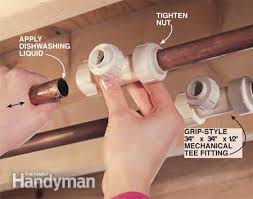<p style="text-align: justify;">A compression fitting is one that consists of an external compression nut and an internal ferrule. These were once characteristically made of either copper or brass. However, plastic compression fittings have soared to the forefront since Philmac brought them onto the scene in 1968.<img class="alignright size-full wp-image-18946" src="https://haznos.org/wp-content/uploads/2013/05/50.jpg" alt="" width="250" height="250" /></p>
<p style="text-align: justify;"> The ferrule differs in shape significantly. However, typically they are round with bevelled rims. This part is used to create a much tighter joint because it effectively closes the room that is connecting the pipe, the receiving fitting, and the nut.</p>
<p style="text-align: justify;"> These fittings are widely utilised across an array of plumbing and electrical waterway systems. In fact, due to their aptitude to offer a leak-tight seal, they are now considered the standard in an array of industries, ranging from the likes of oil and gas to research and development.</p>
<p style="text-align: justify;"> In fact, the most obvious use of plastic compression fittings would be in the home. After all, these fittings are used to connect two pipes together and thus they are a constant in home plumbing. It is likely that most of your appliances that utilise water, such as the dish washer, will require the use of compression fittings.</p>
<p style="text-align: justify;"> It is no coincidence that compression fittings are widely utilised across a whole host of industries; from agriculture to industrial. There are many benefits associated with the application of plastic compression fittings.</p>
<p style="text-align: justify;">One of the main advantages has to be the ease of installation. You won’t face a lengthy or complicated installation process when using these fittings. To give further clarity, this is the process typically involved; slide the nut onto the pipe, fasten the compression ring, slip the pipe into fitting, and then make sure the nut is tight. It is as simple as that.</p>
<p style="text-align: justify;"> In addition to this, plastic compression fittings offer a great level of flexibility. They can be used with an array of different fittings. Not only this, but they can be used in conjunction with other materials too. Thus, plastic compression fittings can easily be used with connecting copper pipes for example.</p>
<p style="text-align: justify;">If you were not to use compression fittings it is likely you would opt to use the method of sweating pipes together. This is an extremely difficult technique and is definitely not recommended for someone who has not been trained in the skill. If you try to carry out sweating pipes together for the first time it is likely that you will experience leaks. Luckily, plastic compression fittings merely require you to follow basic instructions. No training or prior experience is necessary.</p>
<p style="text-align: justify;"> And last but not least, if you do notice after time that there is a slight leak, you need not worry about an elaborate or expensive repair. In most instances you will simply need to re-tighten the nut. Again, when you compare this to a sweated fitting you see the significant benefits, after all with this type of fitting you would have to take everything apart.</p>
<p style="text-align: justify;"> Plastic compression fittings are widely utilised across a vast scope of industries in the current day. As you can see; it is little surprise considering the number of benefits associated with this option.</p>
<p style="text-align: justify;"> Emma Morgan has installed plastic pipework systems, such as the Philmac 3G range, for over ten years now.</p>

Applications Of Plastic Compression Fittings And Its Benefits

Image Source :www.familyhandyman.com